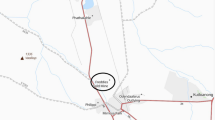Summary
A general expression is derived for the intensity of dryfallout based on time variations of beta-activity in surface air, due to worldwide tropospheric distribution of debris from nuclear testings. Model assumptions are outlined for the consideration of large-scale effects of horizontal divergence of air flow, and small-scale effects of eddy diffusion. The parameterization is based on the concept of geostrophic drag coefficients and atmospheric boundary layer theory. The model is completed by a two-parameter representation of tropospheric profiles of beta activity. Case studies of dry-fallout in 1962 and 1963 at three stations of the United States Public Health Service (USPHS) network are discussed. Dry-fallout rates per day are found to be approximately 10% of average wet-fallout rates of the same period. The average residence time of debris in the troposphere is estimated to be about 65 days if dry-fallout would be the only cleansing process.
Zusammenfassung
Für die Intensität von radioaktivem Ausfall wird eine allgemeine Formel abgeleitet. Sie beruht auf der beobachteten zeitlichen Veränderung der bodennahen Konzentration radioaktiver Beta-Teilchen, die als Abfallprodukte der Kernwaffenversuche weltweite Verteilung erfuhren. Das theoretische Modell zur Berechnung von Trockenausfall erfordert gewisse Annahmen zur Berücksichtigung von 1. großräumigen Effekten der horizontalen Divergenz der Luftströmung und 2. kleinräumigen Turbulenzeinflüssen. Diese Effekte werden durch Parameter der horizontalen Luftdruckverteilung berücksichtigt, die auf dem Konzept des „geostrophischen Widerstandsbeiwertes” und der atmosphärischen Grenzschichttheorie beruhen. Das Modell ist durch zwei weitere Parameter vervollständigt, welche das troposphärische Profil der Beta-Aktivität repräsentieren. Beispiele von Trockenausfall in den Jahren 1962 und 1963 werden für drei Stationen des Beobachtungsnetzes des „United States Public Health Service” diskutiert. Es ergab sich, daß Trockenausfall pro Tag etwa 10% des Ausfalles durch Niederschlag (pro Regentag) für den gleichen Zeitabschnitt ausmacht. Ferner wird abgeschätzt, daß die Verweilzeit der radioaktiven Teilchen in der Troposphäre im Durchschnitt 65 Tage beträgt, wenn Trockenausfall der alleinige Reinigungsprozeß ist.
Résumé
On développe ici une formule générale permettant le calcul de l'intensité des retombées radio-actives. Cette formule est fondée sur la variation de la concentration au voisinage du sol des particules radio-actives béta, disséminées dans l'atmosphère entière à la suite d'essais d'armes nucléaires. Le modèle théorique permettant de représenter la sédimentation en atmosphère sèche nécessite certaines suppositions afin de tenir compte d'une part des effets à grandes dimensions de la divergence horizontale des courants aériens et d'autre part des effets de la turbulence à petites dimensions. On tient compte de ces effets au moyen de paramètres de la répartition horizontale de la pression, paramètres basés sur le coefficient de la résistance géostrophique et sur la théorie des couches limites atmosphériques. Ce modèle est complété par deux paramètres supplémentaires qui représentent le profil troposphérique de l'activité béta. Comme exemple, on discute les quantités de retombées recueillies à trois stations du «United States Public Health Service» durant les années 1962 et 1963. Le résultat en est que la sédimentation à sec par jour représente environ le 10% des retombées entraînées par les précipitations durant la même période. On estime en outre que les particules se maintiennent en moyenne durant 65 jours dans la troposphère si la sédimentation se fait uniquement sans le concours de précipitations.
Similar content being viewed by others
References
Johnson, W. B.: Climatology of Atmospheric Boundary Layer Parameters and Energy Dissipation, Derived from Gregg's Aerological Survey of the US. Section 7, Final Report, Contract DA-36-039-SC-80282, University of Wisconsin, Oct. 1962.
Kung, E. C.: Climatology of Aerodynamic Roughness Parameter and Energy Dissipation in the Planetary Boundary Layer of the Northern Hemisphere. Section 2, Annual Report, Contract DA-36-039-AMC-00878, University of Wisconsin, Nov. 1963.
Lettau, H. H.: Wind Profile, Surface Stress and Geostrophic Drag Coefficients in the Atmospheric Surface Layer. Advances in Geophysics, Vol.6, p. 241–255. New York and London, 1959.
Lettau, H. H.: Theoretical Wind Spirals in the Boundary Layer of a Barotropic Atmosphere. Beitr. Physik d. Atmpsphäre,35, 195–212 (1962).
Machta, L.: A Survey of Information on Meteorological Aspects of World-Wide Fallout. Technical Note No. 43 World Met. Org. Geneva, 1961.
Reiter, R.: A Case Study of Radioactive Fallout. Journal of Applied Meteor.,2, 691–705 (1963).
Author information
Authors and Affiliations
Additional information
With 2 Figures
The research reported was supported, in part, by the National Science Foundation, Grant No. GP-444.
Rights and permissions
About this article
Cite this article
Lettau, H.H., Lettau, K. A meteorological study of Dry-fallout of radioactive debris. Arch. Met. Geoph. Biokl. A. 14, 218–232 (1964). https://doi.org/10.1007/BF02247241
Issue Date:
DOI: https://doi.org/10.1007/BF02247241




